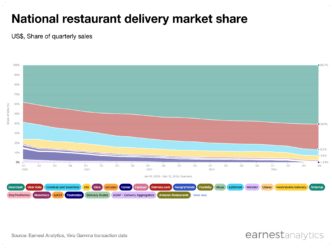Mastering unit economics: predicting future value and uncovering hidden risks
In this episode of Earnest Talks, Michael Maloof, Head of Marketing at Earnest Analytics, sat down with Daniel McCarthy and Jingjing Fan of Theta to discuss ecommerce customer health for Wish, Shein, Etsy, and Amazon using Earnest’s credit card transaction data and Theta’s best-in-class Customer Lifetime Value (CLV) models.
Jingjing Fan on leveraging Earnest’s credit/debit card transaction data for Theta’s research: “Most businesses have access to their own transaction data—but for those that do not, or for those who wish to know how they stack up against their competitors but can’t access their competitors’ data—this is where credit card channel data serves as a great proxy to in-house transaction records. For this analysis we partnered with Earnest, and we were able to get credit card panel data on the 4 companies, Etsy, Wish, Shein, and Amazon. And what we have is over 1 million unique panel members in each dataset with a very long data period going all the way back to January of 2016. So this large sample size, as well as the large data runway, gives us a lot of confidence in the statistical significance of our analysis.”
Dan McCarthy on the definition of and importance of “post-acquisition value”: “There is one definition that we want to to make sure that we’re all on the same page with. And that’s what we call post-acquisition value, or PAV. And really, what this represents is, when you acquire a customer, you’re going to get revenue from that customer into the future. And so the question is, how much revenue is it? And so what PAV supposed to represent is the net present value. Basically the sum of all the revenue that we’re going to get until customers churn, but when we account for the time value of money. And so it’s not quite profit-based customer value, but it is a measure of how much top line you should be expecting when that next customer comes in.”
Jingjing Fan on Etsy’s cross-cohort weakness and erosion of active customer base: “We see that people’s first purchase average order value has increased somewhat over the years. However, the repeat purchase order values have not. And so when you combine this drop in repeat transactions, the slowly shrinking active customer base, and a kind of a lackadaisical growth in average order value, we can really easily see why average post-acquisition values might be dropping for Etsy. It makes a lot of sense, and Wish is a very similar story.”
Jingjing Fan on Amazon’s improving AOV but cross-cohort weakness: “What is nice about Amazon, though, is that their active customer base seems to be very stable. They do not seem to be losing very many customers, or on their average order values for both repeat orders and first purchases. First purchases in particular have grown quite significantly. However, these are not quite enough to offset the fact that their newer customers are not projected to make as many repeat purchases over their lifetime. Something that could be leading to this is the fact that many of their competitors—Target, Walmart, these other big box companies—have been really ramping up in the e-commerce space, pulling away some of the necessity of buying from Amazon.”
Jingjing Fan on Theta’s main findings for Wish, Amazon, and Shein: “Our takeaways were that Wish customers are nearly worthless. They will buy once, and then they’re done. Amazon customers are an entire order of magnitude higher than that of other companies. However, they are still experiencing significant cross-cohort decline. And then, lastly, it is possible, as we saw in the case of Shein, for your repeat purchase rate to go up but for your PAV to still go down as long as long as your retention and your average order values are not all heading in the same direction.
Dan McCarthy on Theta’s new model, CLV Ultra, and its implications: “It allows us to predict better what young customers will do. And I can’t stress enough how important this is, because imagine that you’re a marketing manager. What you want to know is, where should I acquire customers today? What that means is, what is the projected value of customers that I haven’t even acquired yet? It also allows us to have those individual level insights. So you don’t get that great fit at the cost of only having the modeling being done at the cohort level…it also allows for more diagnostic assessment of customer value trends across the cohorts.”











